Stalking the Wild Grape
Join me on a fun adventure foraging for wild grapes, then turning them into grape juice. Free all-natural food–how good is that!
Found food. As in food you find–right out in nature. Organic. Healthy. Free even. How good is that? When my daughter announced she had found a large patch of wild grapes, right along the bike path, I was excited.
You see, I had discovered the pleasure of wild grapes a few years ago. Small and tart, wild grapes are great for juice and jelly making. If you have never seen wild grapes, they aren’t large juicy fruits like backyard concords or supermarket reds. Tart and tannic, they won’t compete for fresh eating either. But wild grapes are loaded with antioxidants and, processed correctly, make a delicious juice or homemade jelly.
In Search of the Wild Grape
Wild grapes grow in small clusters of petite berries on long vines, often along the edge of woods. They use curled tendrils to climb the trees and it can take a bit of hunting to find enough within arm’s reach. Wild grapes ripen in early to mid fall and the best time for picking is a brief window when the clusters are mostly purple (vs having a lot of still-green fruits) but before the older grapes begin to shrivel and decay. The last weekend of September was perfect this year in Wisconsin.
You need a couple gallons (e.g. ice cream buckets) of clusters to make a reasonable quantity of juice—which is easy if you find a big clump, but challenging if you need to traipse along a lot of country roads. I don’t mind an extended search on a brilliant fall day, but on a cold one… A scissors or pruning shears will make harvesting easier.
As with any wild foraging, you need to make sure you are getting the correct plant. Take a look at articles like this (and I recommend checking more than one source) for (relatively easy) instructions on how to distinguish wild grapes from the poisonous moonseed plant.
What to Do with Wild Grapes
As I’ve mentioned, wild grapes are not likely to find fame as a fresh eating fruit. The problems range from size (teeny) to tartness (pucker up) to a high tartaric acid content that may actually cause stomach and skin irritation (see tips on how to avoid this below).
I have always used my wild grapes for juice. I make and can a concentrate, then mix it with plain or fizzy water for a beverage that is healthier and tastier than a commercial soft drink. Other people use wild grapes for jelly and or a homemade sweet wine. 
How to Work with Wild Grapes
There are a number of different species of wild grapes and some may require fewer precautions than the high tartaric acid species I find here in Wisconsin. But it won’t hurt to take the extra preparation steps—better safe than sorry!
The first step is pressing the grapes. This can be done right on the stems though I prefer to separate the grapes first. Many people recommend pressing with a glass or your hands rather than a mechanical process which may nick the seeds and produce a bitter flavor (I don’t have a juicer so I have always pressed manually). If you use your hands, gloves are recommended since some people report painful skin irritation. I am normally careful but my daughter got really into it (literally) and commented on a mild itchiness afterwards (though not as bad as the time she barehanded the world’s hottest poblano peppers).
After pressing you strain the juicy pulp, ideally through cheesecloth, and let the juice sit in the refrigerator overnight. The tartaric acid will settle on the bottom of your container and you can pour the juice off the top and discard the (seriously unappealing) sludge. And yes, sludge is an apt description.
Some people suggest you avoid cooking the grape pulp, again due to the possibility of adding bitterness. This year I didn’t have any cheesecloth to squeeze out the last of the juice so decided to try an experiment. After pressing and straining, I covered the remaining skins and seeds with water and simmered them for about 15 minutes. I then strained this mixture to create additional juice. I also let this sit overnight to separate and discard the “sludge”. After sweetening, this “second pressing” was quite tasty, so I may continue this process to increase my yield.
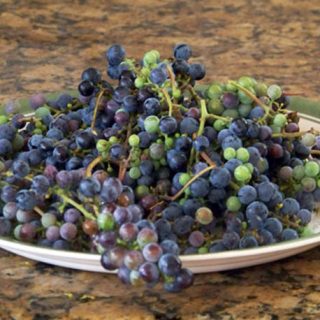
Wild Grape Juice
Ingredients
- 2 or more gallons of wild grapes, including stems
- 3 cups of sugar or more to taste
- 2 cups water
Instructions
- Remove grapes from stems and press grapes to extract juice. Strain through a strainer lined with cheesecloth, then squeeze the cheesecloth to release as much juice as possible. Discard the remaining pulp. Let juice sit in your refrigerator overnight until a sludge settles on the bottom. Pour the juice off the top and discard the sludge. You should have about 3-4 cups of juice.
- In a large saucepan over medium heat, stir water and sugar together until sugar is dissolved and syrup is hot. Add strained juice and stir to combine. Taste test for sweetness by putting a teaspoon of juice in a glass then adding water. Add sugar as needed. If you plan to can the juice, bring it back to just below boiling.
- The resulting juice concentrate can be frozen or canned in a water bath in pint jars processed for 5 minutes, adjusting for altitudes over 1000 ft. For complete canning instructions, see the link below.
- To serve, mix 2-3 tablespoons (or to taste) of concentrate with fizzy (or plain) water.
Nutrition

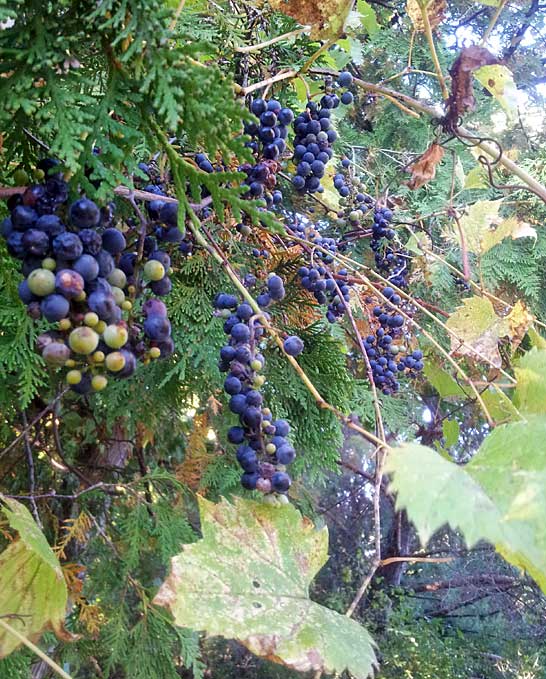
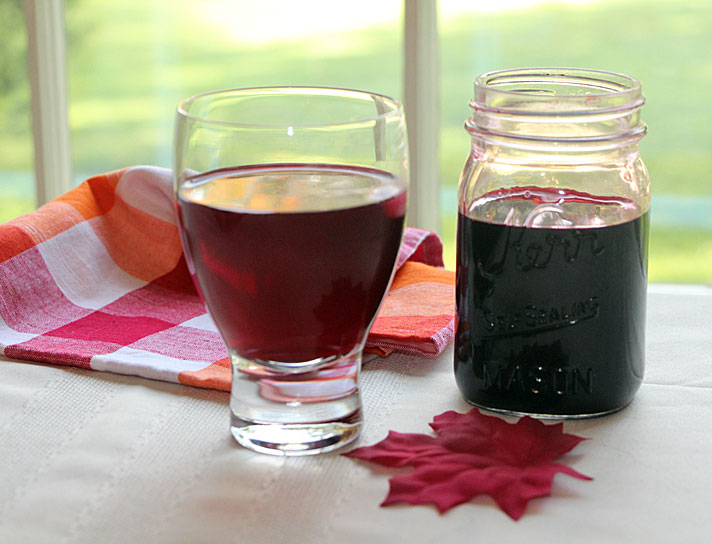
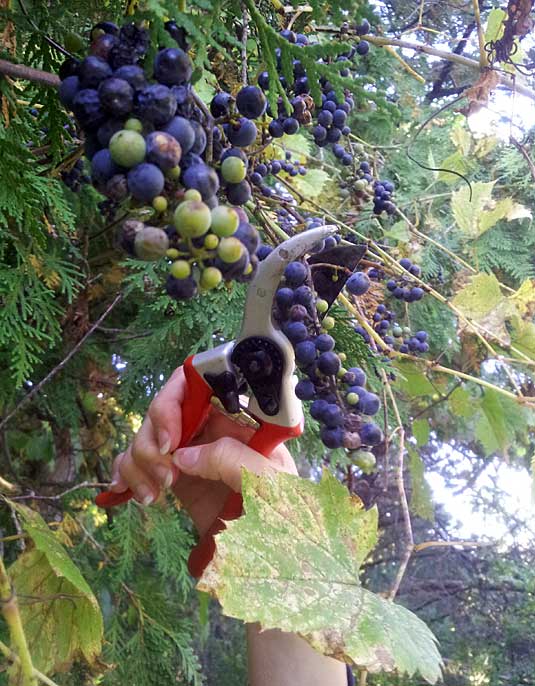



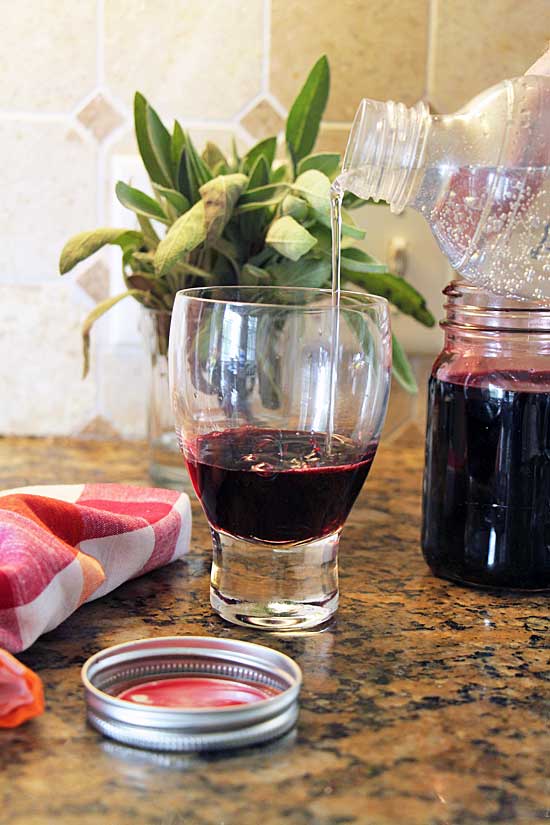



I wait till after the first frosts and the leaves drop to get the max sweetness. Then I freeze them so its easier to pick berries from the stems, also freezing seems to help make them sweeter. add water and simmer for 20min. Pour thru collander to get rid of seeds and then squeeze pulp thru cheesecloth to get max juice. Then add small amount of sugar and a package of No Sugar Pectin. Boil 10min or until it thickens to jam consistency and can it. Makes nice tart no sugar jam that you cant buy anywhere.
You know I love the idea of freezing them–thanks for the suggestion! I am so busy dealing with my CSA veggies that it would be nice to be able to defer this until winter. We aren’t big jam/jelly eaters in my family but I know many people like using the wild grapes for this.
My husband came in with a bucket of wild grapes. The clusters are large and beautiful. I am going to try to make juice. If your very careful can you eliminate bitterness of the grape?
Be sure to let the juice sit so that any sediment can settle out which can be bitter and irritating (this will depend somewhat on your specific local grapes). Sugar counteracts bitterness and extra water dilutes the intensity so your final product will taste much better! If it still tastes bitter and isn’t too sweet (I think I am probably on the low side with sugar), you can even increase the amount of sugar a little at a time and see if that helps. Salt and fat can also neutralize bitter flavors but those are not generally things you want to add to fruit juice 😉 . I don’t remember thinking the final product was too bitter, so hopefully you like it in the end! I am planning to go grape picking this afternoon!
I discovered them about 5 years ago in my backyard, I let them grow because it covered up my fence so nicely. And one day I saw the grape bunches, my curiosity got the best of me and I started doing my research, first I tried to get my brother to taste them but he didn’t fall for that lol. So after my research I finally tried one, everything checked out. And I had just enough to make 8 jars of jam, the next year I explored our state parks and yup there are tons there.This last 2 years though my crop in my backyard is so big, I want to explore making wine. Last year I made 80 jars of jam, gave it away to all my family. Making grape juice sounds good too.
Wow that’s a lot of jam! Yes, we kept tossing the waste in the backyard and ended up getting some growing after a few years. But the state park was a great foraging ground for us too–right along the bike trail happily! Isn’t it fun!
Is it OK to use the green grapes (unripe)or throw those out?
I have been tossing the green grapes out. I know an occasional one probably slips through, but I do try to discard them. Have fun!
Funny! At my house they are all over our 3 acres! They grow up into trees, all over fencing, in the woods… almost invasively 🙂 The birds go crazy for them. Seems like everybody has a favorite juicing process. One old guy told me he grew up making grape juice right in the jars. Throw some clean ripe grapes, water, and sugar in the jars, cap, and process in boiling water bath. No muss no fuss, worked great! Makes a strong concentrate. * Rating system isn’t allowing me to click more than 2 stars ?? Maybe it will show more when I post??
I am seeing a lot of vines and small clumps this year, so I think it’s going to be a good year! I had heard the can whole method too–a little worried about the sludge doing that since the variety that grows here is especially high in that. But perhaps I’ll test can a jar this year. Let me take a look at the rating. Thanks for letting me knoow!
I make my grape concentrate by combining equal parts sugar and juice. Much like making simple syrup. I can it. When ready to use, I fill a glass with ice, pour 1/3 glass juice concentrate then fill the rest of the glass with fizzy water. Yum Yum.
Sounds like you really have this down Debbie! Enjoy!
I’ve been working on this today. Can you tell me what is the ratio of concentrate to water is when mixing? I was happy with how my jelly turned out, can’t wait to try this juice! I get my wild grapes off the vines in the trees on our fence line up by Shiocton. Thanks again!
I don’t think we did a firm ratio of concentrate to water when mixing. Just to taste. I get mine in Door County so north Wisconsin grapes either way 🙂
My son & I came across a whole bunch yesterday.. We could smell them.. with the abundant rain this year they are roughly twice the size the usually are.. Also amazingly sweet.. I’m trying to find a use for my new found free food..
Isn’t free food fun!
Juice, juice, juice!! With juice you can make jelly, spritzers, juice blends, add to smoothies! If you don’t want to can, put juice in freezer bags in measured portions (1 cup, 2 cups…). When company comes, make a quick sugar syrup on the stove, put it in a pitcher with frozen juice, add sparkling water, ice, and you have a delicious beverage. If you’re feeling really bold, add some wine 😉
I moved into a house which has a very large wild grape vine in the backyard. I’ve picked at least two gallons off already and that’s barely scratched the surface. They are in a tall tree. Will it harm the vine if I move it to an arber?
I have tried to start wild grapes without success but I have never tried transplanting one. My thought is that your chances would be better in the spring when the growth is less. Or if it is possible to leave the roots intact and just guide the vine next year, even better. Good luck.
Inger, I am a friend of your cousin Sue (if you are the Inger I am thinking of)!
What a treat to see your post. Just picked a bag of grapes off the railroad path in Racine. Making juice as I post!
Jayne
Yes, Jayne, I am that Inger! Hope you had fun with your grapes. My daughter and I were just saying the wild grapes seem early this year! Thanks for commenting!
Love the wild grapes but here. In ks they seem to LOVE to grow with poison ivy or the other way around .This past fall I had crawled all the way into the patch cause that’s where the mother load was when I saw the dreaded plants. But in all total I probably had 20 gal of grapes. I still had a couple gal frozen going to make co concentrate and try to start some seeds. Supposedly it can be done but they need a time of freezing temps and soak the seeds 24 hours before planting
That’s a lot of grapes Martha! None of the seeds I’ve dumped out has grown so if I get serious maybe I’ll try soaking them. Getting freezing weather isn’t a problem!
Pingback: Top Note Tonics, Ginger Jack Cocktail & More - Art of Natural Living
This is the most fun post ever. Love it. I would take a big bunch and make a rum infusion also!
Wow, I have never seen wild grapes…great idea to make a concentrated juice…and the idea of adding fizzy water sounds delicious!
I am making a lot of fruit syrups to mix with the fizzy water–my favorite new beverage! Hope you have a great weekend Juliana!
Sounds delicious. You were so lucky to find a bunch in such a great location!
I was lucky–and I’ve made a note to look there again next year!
Inger- I remember wild grapes from my childhood in Pennsylvania. We never ate them, because we were always afraid they were poisonous. Now I wish I could go back and pick some! Thanks for a great post.
Better safe than sorry David! And there’s still time to get some wild grapes into your life (okay maybe not this year…)! I just ate my first shaggy mane mushroom after watching them pop up in the lawn for years. A week ago and I’m still here so I guess I got it right 😉
I always use wild grapes to supplement homemade Concord wine. Gives it a great dark color and lots of tannin’s. And yes very sour by themselves. I find them easy to spot in fall because the leaves seem to turn yellowish before the rest of the foliage around. They also love to hang around river edges. Really you can find them just about anywhere, you just have to look.
What a great tip on blending with the Concords Mark. We aren’t growing any of our own grapes yet but they are definitely in the plans for the future!